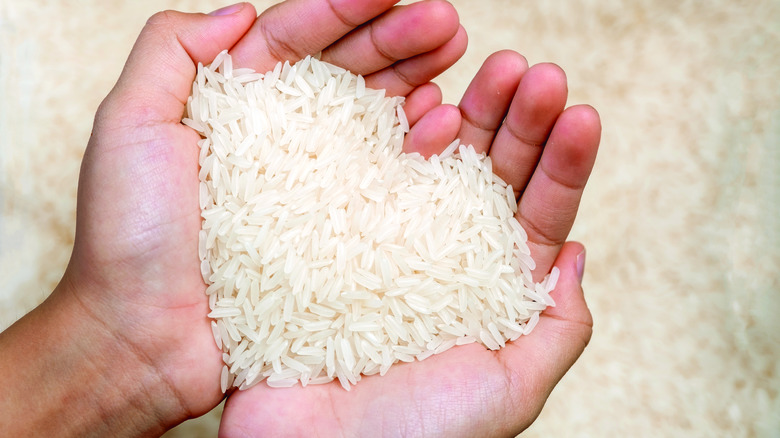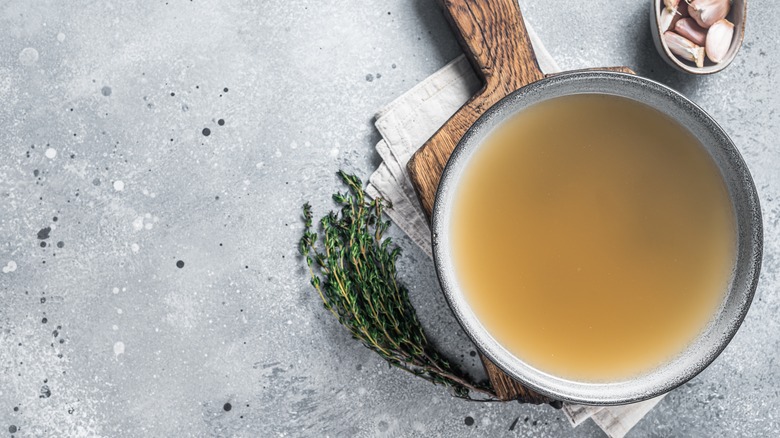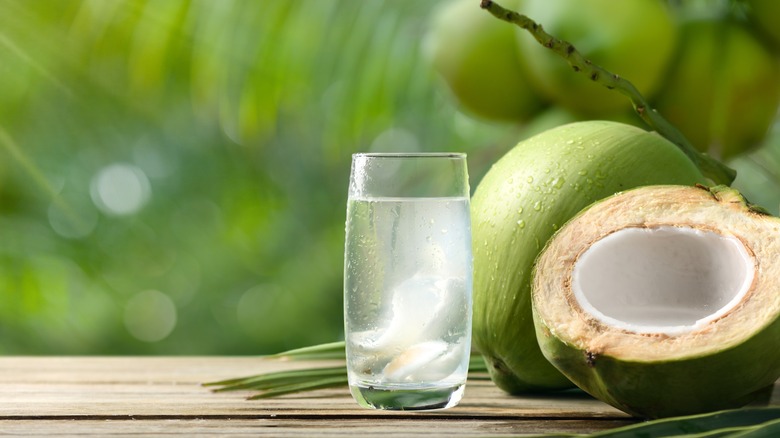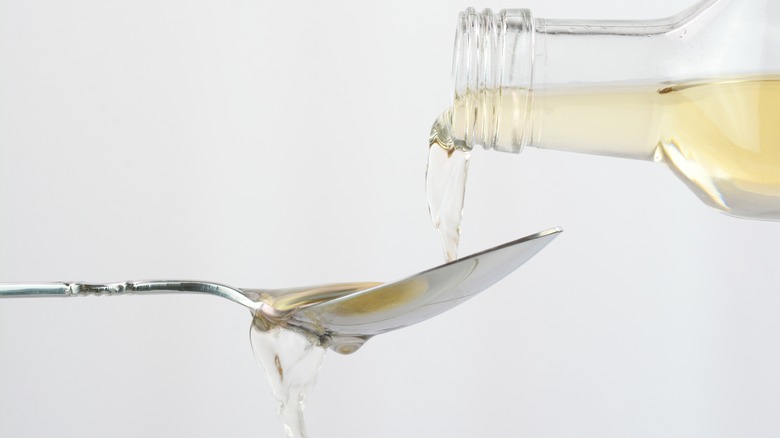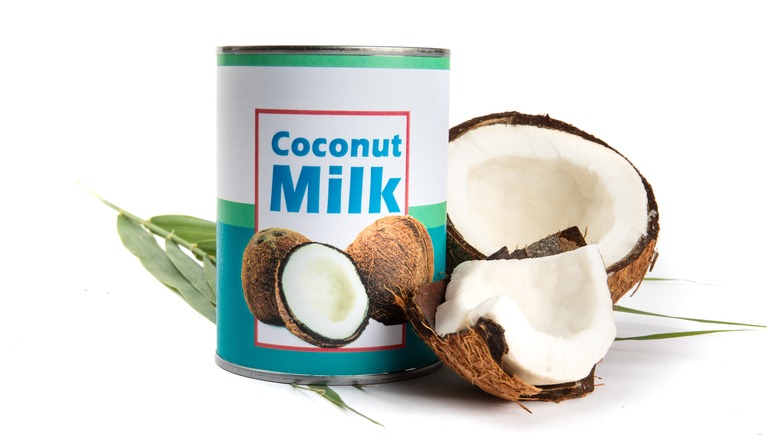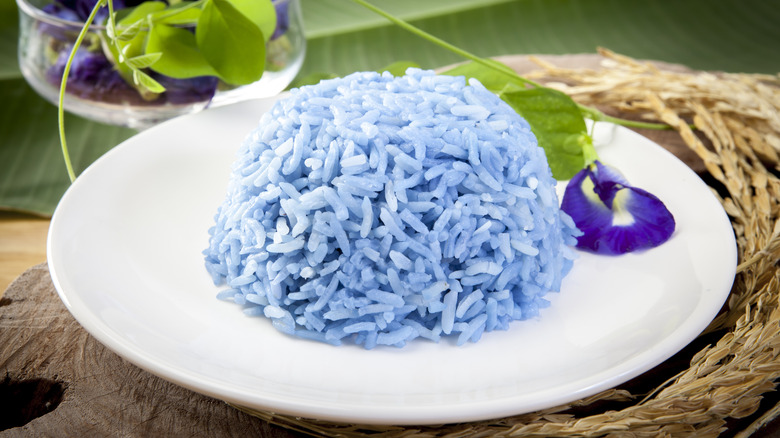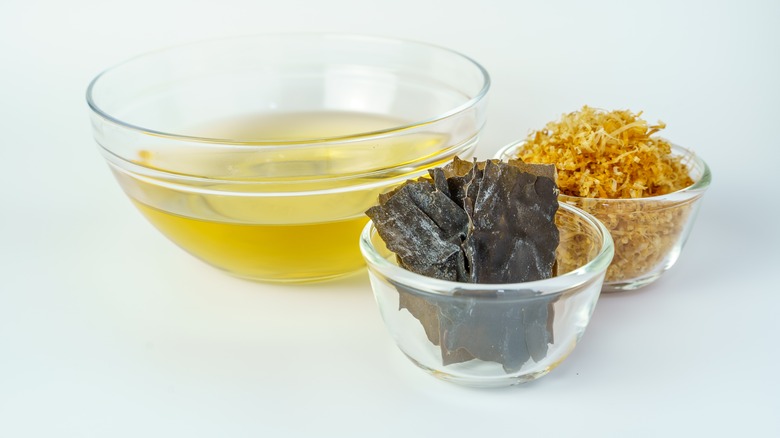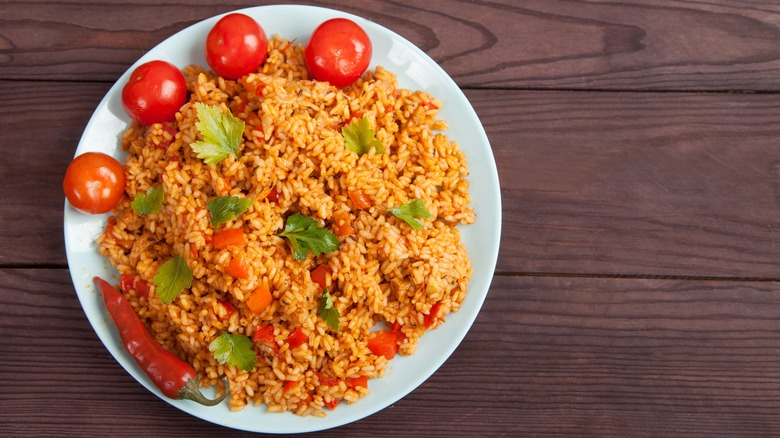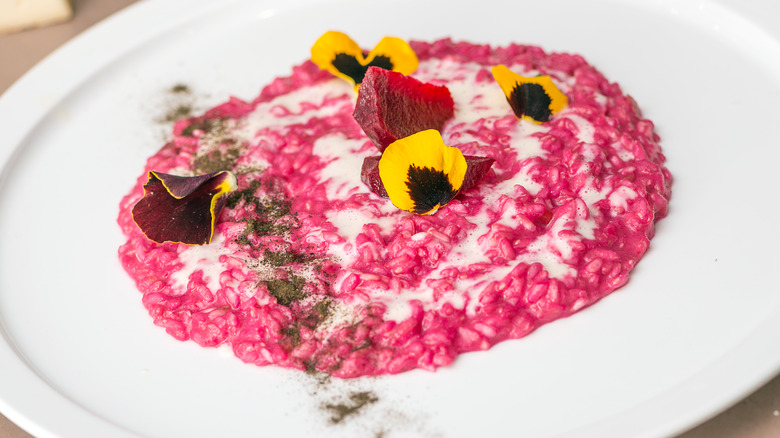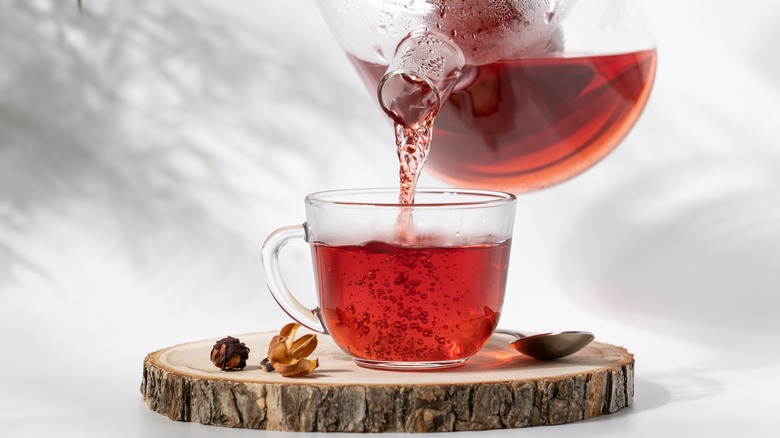Try Cooking Rice In These Liquids And Thank Us Later
Cooking rice typically requires two simple ingredients: rice and water. The basics are also simple as you just need to cook the rice until all the water is absorbed. Steamed white rice is a staple food in many cultures and it's easy to make on the stovetop without any fancy kitchen appliance. Plain rice is a great side dish, usually eaten as an accompaniment for meat or vegetable dishes. If the other foods on your menu are strongly flavored or salty, it makes sense to eat them with plain white rice. And there are many tasty ways to spruce up the rice itself.
For example, swapping the liquid you cook the rice in can change the flavor, texture, and color of rice. Let's take a look at several liquids you can use to take your rice dish to a whole new level — not to mention adding more nutrients and proteins to your diet.
Chicken broth
Using chicken broth instead of plain water is an easy swap for cooking white rice. The chicken broth adds a lot of savory flavor to the rice and it is also more nutritious. In fact, the Singaporean national dish, Hainanese chicken rice, uses rice cooked with chicken broth which is served with steamed chicken and a ginger and chile garlic sauce. Dietitian Lauren Manaker cooks her rice with broth because it "gives the final product added fat, flavor, and protein."
As the rice soaks up the chicken broth, all the nutrients will also be absorbed. The broth is a simple 1:1 swap, so you can use the same liquid to rice ratio for chicken broth as you would with regular water. Alternatively, if you want a milder flavor in the final result, you can use part water and part broth to cook the rice in. The swap works the same way with other types of broth, such as beef broth and vegetable broth.
Coconut water
Coconut rice is commonly found in countries where both rice and coconut are abundant, like Southeast Asia and the Caribbean. If you want to make coconut rice, this Food Republic article suggests using coconut water instead of coconut milk. Because coconut water's consistency is similar to plain water, cooking rice with coconut water works pretty much the same way as cooking regular rice. Online recipes suggest using the same ratio of coconut water to rice as plain water.
If you want a milder flavor you can also try different proportions of water and coconut water. The coconut water gives the rice a sweet coconut flavor and aroma that would make the rice a great side dish for Thai curry, or to elevate a chicken and rice dish. Plus, coconut water contains potassium, calcium, and magnesium, so it's a good way to add these nutrients to your rice while keeping it low calorie.
Vinegar
If you haven't been able to get your rice quite as fluffy as you'd like, consider adding a splash of vinegar. Cooked rice can stick together and become gummy because of the excess starch, but acidic ingredients like vinegar can prevent this from happening. The acid can help stop starches from thickening and result in fluffier rice. Additionally, vinegar has many health benefits and helps to kill harmful bacteria.
Vinegar also acts as a seasoning and adds a nice flavor to the rice. In fact, rice vinegar is one of the main ingredients for making sushi rice. Although in sushi rice the vinegar is typically added as a seasoning after the rice is cooked, you can shake in a splash of vinegar before cooking instead to break down the excess starch from the rice. Only a small amount is needed and most recipes suggest adding 1 teaspoon of vinegar for each cup of rice.
White wine
The Italians have been cooking their rice with white wine for a long time, and there is good reason. White wine is a common ingredient for risotto — in fact, La Cucina Italiana suggests it's a mistake to skip the alcohol when making risotto — so it's only natural that white wine would also work well for making a pot of rice. Cooking rice in white wine elevates the flavor of the rice because of the acidity of the wine, and it's just as easy as using water. Especially if you're cooking rice in a rich chicken broth, adding white wine can add a nice acidity to balance out the flavors of the dish.
VinePair says cooking rice in chicken broth and white wine is "... the secret to mind-blowing rice." Don't worry about the alcohol content, though, as most of the alcohol will evaporate during the cooking process.
Coconut milk
Cooking rice with coconut milk is more difficult than coconut water because coconut milk is a more viscous liquid — but it is worth the reward once you pull it off. While coconut water imparts the flavor and sweetness of coconut, coconut milk does that and more. The fat in the coconut milk also lends a richness to the texture of the rice. As canned coconut milk has a long shelf life, this is a great hack to keep in the back pocket.
When cooking rice with coconut milk, recipes usually suggest combining coconut milk and water, as coconut milk alone would be too thick. For example, try replacing half of the water with coconut milk. This Instant Pot coconut rice recipe also suggests using basmati rice instead of short grain rice to prevent the rice from sticking together because long grain rice like basmati has less starch.
Butterfly pea tea
Butterfly pea flower is a bright blue flower native to Southeast Asia and it's been quite the rage as a natural blue food coloring. Butterfly pea has been in a lot of cocktail recipes and to create Empress 1901 gin's indigo color. Adding butterfly pea tea when cooking rice will give the rice a striking blue color. Butterfly pea tea has a mild flavor and a little goes a long way in terms of color, so as long as you don't add too much, there's no worry about affecting the flavor of the rice.
In South Asia and Southeast Asia, butterfly pea flowers are commonly used to make tea and for cooking and they're believed to have many health benefits. It's also commonly used to make nasi kerabu, a Malaysian rice dish that even the Malaysia-based airline Air Asia calls "the most beautiful rice dish in Southeast Asia."
Dashi
Dashi is a stock that is the base of a lot of staple Japanese dishes such as miso soup and sauces made for dipping. The stock is commonly associated with umami flavor. Dashi can be made vegan using kombu (kelp) and shiitake mushrooms, or it can also incorporate bonito fish flakes. Don't worry if making dashi sounds intimidating, you can always buy instant dashi powder.
Cooking rice with dashi is an easy way to add lots of umami flavor — and using vegan kombu dashi (made from seaweed that has been dried) is another way to enhance the taste of rice. A simple meal to prepare is takikomi gohan, or Japanese mixed rice. Takikomi gohan is basically a one-pot-meal where you cook rice with dashi and other ingredients like mushroom, vegetables, or meat such as chicken — it all goes into the rice cooker or pot.
Tomato paste
Adding tomato paste to rice adds both a nice red color to the rice and a tangy flavor. The use of tomato in cooking rice is also pretty common around the world from Latin America to Africa. West African jollof rice recipes, for example, call for either a can of tomatoes or tomato paste. Mexican red rice or Spanish rice is also made using tomatoes among other flavorful ingredients such as onion and garlic.
While you can make tomato sauce using fresh tomatoes, shelf-stable tomato paste is handy to keep in the pantry for whenever you want to add something extra to your rice. Of course, because tomato paste is too thick to cook rice in by itself, the tomato paste is usually added to other liquids such as rice or chicken stock — this recipe shows you how to make a basic Mexican rice using 2 tablespoons of tomato paste for 1 cup of rice.
Beet juice
Beets have a number of health benefits, from lowering blood pressure to fighting inflammation. Plus, beets are also delicious so cooking rice with beets is one way to not only make your rice healthier and more nutritious, but also more flavorful. Beetroot rice is a popular recipe in India that is healthy and vegan — but instead of using cut or grated beets, you can achieve a similar dish using beet juice.
To make the rice more savory, try combining beet juice with chicken stock and using it to cook rice. Color is the bonus in making rice with beet juice. Thanks to the bright pink color, when rice absorbs beet juice, it also takes on the vibrant hue — so you can have rice that is pretty in pink without adding any artificial food coloring. Alternatively, instead of making steamed rice with beet juice, you can use the juice to make beet risotto with cheese.
Tea
One of the more inventive and unexpected ways to elevate rice is to cook the rice with tea. Cooking rice with tea is an easy way to add a variety of flavors to your rice and it's good to keep handy in your pantry since tea doesn't really expire. For inspiration, this TikToker video combines jasmine rice with ginger tea.
While combining tea and rice isn't new, such as in Japanese ochazuke where hot green tea is added to cooked rice, using tea as the liquid to cook the rice itself is more unusual. It's one hack that is easy to do with minimal effort, and it is also fun to experiment with different types of tea. One writer tried to cook rice with a bag of Sleepytime tea and said, "It was honestly perfect." Just imagine the possibilities of flavors you can add to your rice with this hack.
